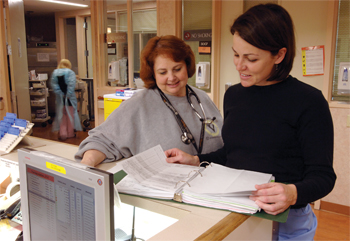
Regenia Wisecarver, R.N., B.S.N., left, and Patricia Frawley, R.N., B.S.N., both charge nurses in the Surgical Intensive Care Unit, review patient charts.
Photo by Anne Rayner
Numbers show SICU improvements paying off
As the calendar year closed, the staff of Vanderbilt University Medical Center's Surgical Intensive Care Unit (SICU) had a lot to celebrate, primarily the way physicians, nurses and support staff worked together to enhance the way the SICU cares for patients and interfaces with other departments.
The results are evident in the numbers as well as on the faces of SICU patients and staff. Consider: survival rate is 92 percent, which is significantly better than the national benchmark; skin breakdown rate is below national levels; ventilator-associated pneumonia is roughly half of what it was four years ago; successful implementation of tight glucose control has resulted in more than 75 percent of patients values falling within a range of 80 to 140 mg/dl, which is well above nationally reported statistics; and self-extubation rates are well below national benchmarks.
“The SICU is like no other department at VUMC,” said Addison May, M.D., associate professor of Surgery and Anesthesiology, Division of Trauma and Surgical Critical Care. “In many ways we have conflicting roles. We serve as an extension of many other medical teams while maintaining a self-contained unit. This approach requires a lot of energy and coordination on behalf of our physicians and nurses to make things work and help patients recover.”
VUMC has several specialized intensive care units. Unique among them, the SICU serves a broad range of patient populations. On a typical day, staff can attend to patients recovering from general surgery, liver transplants, pancreas transplants, vascular surgeries, head-and-neck cases and a variety of other complex procedures.
“SICU nurses are frontline clinicians who have to deal with minute-by-minute updates on a wide cross-section of patient needs,” said Devin Carr, M.S.N., SICU nurse manager.
May and Carr started working with staff to enhance patient outcomes by focusing on building a cohesive interdisciplinary team.
“Intensivists, nurses, critical care fellows, clinical pharmacists and respiratory therapists have been brought together with a common goal of continuously improving patient outcomes,” said May. “While we believe that we were already doing well, we felt we could achieve more.”
The team leaders developed and implemented numerous best-practice protocols and guidelines, such as goal-directed sedation, maintenance of euglycemia, empiric therapy for ventilator-associated pneumonia and central line insertion and management. The SICU also implemented Project Impact, a critical care database system that provides the ability to measure outcomes and benchmark against national standards.
The leadership devoted considerable time and energy into maintaining and recruiting staff during this period.
“What we've done is really a page out of VUMC's elevate campaign,” said May. “The first pillar is people, and we set out to develop high-level expertise in the care of critically ill patients. We wanted to make sure we continued to add to the considerable expertise of the unit.”
The 100-person staff ranges from fairly new employees to those with more than a 30-year history with VUMC. May and Carr recognized the challenges for the nursing staff who are responsible for 7,000 patient days each year. Working closely with SICU Assistant Manager Mike Daly, M.S.N., the team started making some important changes.
All new staff receives extensive, customized training coordinated by Richard Benoit, M.S.N., clinical nurse specialist. “We have very skilled critical care nurses who are constantly learning. In the SICU, learning never ends,” said Carr.
Nursing staff is empowered and has a new sense of ownership. He and the staff have worked together so that now, the nurses are truly decisive and independent thinkers.
“We have eight of the best charge nurses in the country,” said Carr.
Staff members are also helping enhance communication. For example, one staff member volunteered to put all the policies online. Another started the Pay Day Post SICU newsletter so everyone knows what's happening throughout the department, regardless of shift of duty. The result of all these measures has been consistency and low turnover.
Dinah Hazlett, SICU nurse, has been at Vanderbilt University Hospital since 1977 and in the SICU since 1983. She notices the improvements. “We have a high-quality staff and we work better together,” she said. “Management really listens to us.”
“I'm so proud of our staff of nurses and physicians,” said May. “I don't believe anyone can do it better than we can.”













